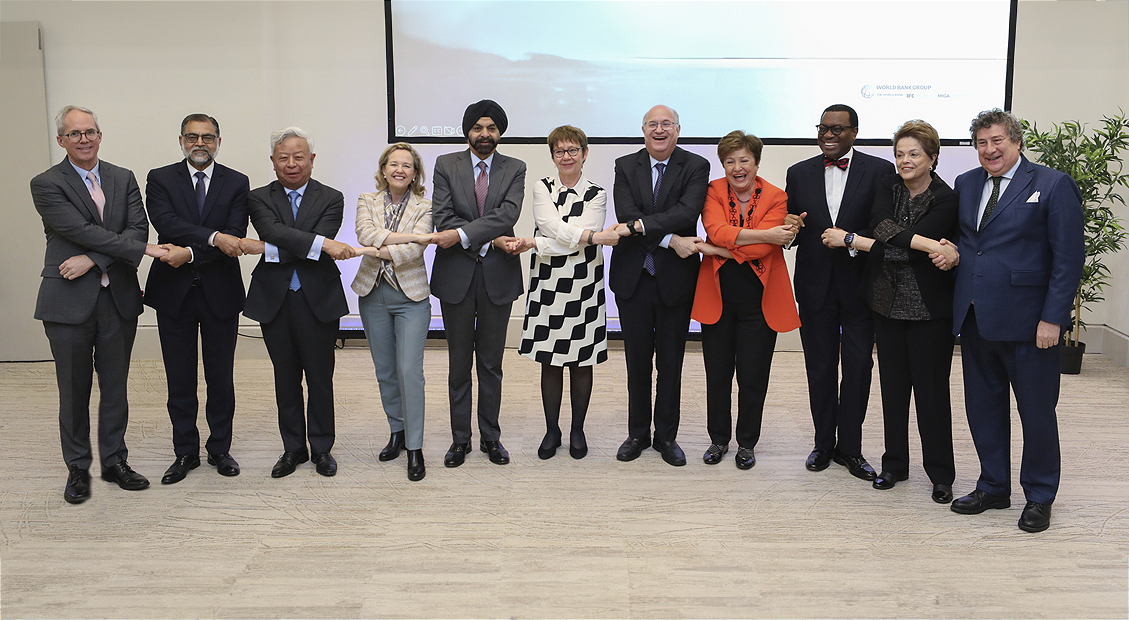
The Leaders of Multilateral Development Banks (MDBs) Announce Joint Steps to Accelerate Progress Towards the Sustainable Development Goals (SDGs)

In a report published at the conclusion of a retreat hosted by the Inter-American Development Bank (IDB), the leaders of 10 multilateral development banks (MDBs) have outlined key deliverables for joint and coordinated action in 2024 and beyond. This initiative builds on the progress made since their Marrakesh statement in 2023, as the MDBs work towards accelerating progress towards the Sustainable Development Goals (SDGs) and providing better support to clients in addressing regional and global challenges.
Strengthened Collaboration Among MDBs
The actions outlined in the report represent the strengthened collaboration amongst MDBs. The report will also serve as a valuable contribution for the forthcoming G20 Roadmap to evolve MDBs into a “better, bigger, and more effective” system, as well as in other relevant forums.
Concrete and Actionable Deliverables
The MDB Heads have committed to concrete and actionable deliverables in five critical areas:
-
Scaling up MDB financing capacity.
- Offering a diverse set of innovative financial instruments to shareholders, development partners, and capital markets, including hybrid-capital and risk-transfer instruments.
- Promoting the channeling of the IMF’s Special Drawing Rights (SDRs) through MDBs.
- Providing more clarity on callable capital to help rating agencies better assess its value.
- Continuing to implement and report on the G20 Capital Adequacy Framework (CAF) Review recommendations and related reforms.
-
Boosting joint action on climate change.
- Increasing common engagement on climate change.
-
Strengthening country-level collaboration and co-financing.
- Assessing proposals on country-led and country-owned platforms to facilitate collaboration.
- Harmonizing procurement practices to reduce transaction costs and increase efficiency and sustainability.
- Accelerating co-financing of public-sector projects through the Global Collaborative Co-Financing Portal.
-
Catalyzing private-sector mobilization.
- Scaling up local-currency lending and foreign-exchange hedging solutions to boost private investment.
- Expanding the type and disaggregation of statistics released through the Global Emerging Markets Risk Database (GEMs) Consortium to support investors in assessing risks and opportunities.
-
Enhancing development effectiveness and impact.
- Increasing collaboration on joint impact evaluations and sharing approaches to monitoring and assessing impact.
- Taking stock of key performance indicators (KPIs) on nature and biodiversity and exploring alignment possibilities ahead of COP30 in 2025.
For more details, please refer to the Viewpoint Note.
About AIIB
The Asian Infrastructure Investment Bank (AIIB) is a multilateral development bank focused on financing the Infrastructure for Tomorrow. Established in Beijing in January 2016, AIIB has grown to 109 approved members worldwide. With a capitalization of USD100 billion and a Triple-A rating from major international credit rating agencies, AIIB collaborates with partners to unlock new capital and invest in sustainable, technology-enabled infrastructure that promotes regional connectivity.
SDGs, Targets, and Indicators in the Article
1. SDGs Addressed or Connected to the Issues Highlighted in the Article
- SDG 1: No Poverty
- SDG 2: Zero Hunger
- SDG 3: Good Health and Well-being
- SDG 4: Quality Education
- SDG 5: Gender Equality
- SDG 6: Clean Water and Sanitation
- SDG 7: Affordable and Clean Energy
- SDG 8: Decent Work and Economic Growth
- SDG 9: Industry, Innovation, and Infrastructure
- SDG 10: Reduced Inequalities
- SDG 11: Sustainable Cities and Communities
- SDG 12: Responsible Consumption and Production
- SDG 13: Climate Action
- SDG 14: Life Below Water
- SDG 15: Life on Land
- SDG 16: Peace, Justice, and Strong Institutions
- SDG 17: Partnerships for the Goals
The article mentions that the leaders of multilateral development banks are working to accelerate progress towards the Sustainable Development Goals (SDGs). While the specific SDGs are not explicitly mentioned, the SDGs listed above are all relevant to the development challenges being addressed by the MDBs.
2. Specific Targets Under Those SDGs Based on the Article’s Content
- SDG 1.5: By 2030, build the resilience of the poor and those in vulnerable situations and reduce their exposure and vulnerability to climate-related extreme events and other economic, social, and environmental shocks and disasters.
- SDG 2.1: By 2030, end hunger and ensure access by all people, in particular the poor and people in vulnerable situations, including infants, to safe, nutritious, and sufficient food all year round.
- SDG 3.8: Achieve universal health coverage, including financial risk protection, access to quality essential health-care services, and access to safe, effective, quality, and affordable essential medicines and vaccines for all.
- SDG 4.3: By 2030, ensure equal access for all women and men to affordable and quality technical, vocational, and tertiary education, including university.
- SDG 5.1: End all forms of discrimination against all women and girls everywhere.
- SDG 6.1: By 2030, achieve universal and equitable access to safe and affordable drinking water for all.
- SDG 7.2: By 2030, increase substantially the share of renewable energy in the global energy mix.
- SDG 8.10: Strengthen the capacity of domestic financial institutions to encourage and expand access to banking, insurance, and financial services for all.
- SDG 9.1: Develop quality, reliable, sustainable, and resilient infrastructure, including regional and transborder infrastructure, to support economic development and human well-being.
- SDG 10.4: Adopt policies, especially fiscal, wage, and social protection policies, and progressively achieve greater equality.
- SDG 11.3: By 2030, enhance inclusive and sustainable urbanization and capacity for participatory, integrated, and sustainable human settlement planning and management in all countries.
- SDG 12.2: By 2030, achieve the sustainable management and efficient use of natural resources.
- SDG 13.1: Strengthen resilience and adaptive capacity to climate-related hazards and natural disasters in all countries.
- SDG 14.2: By 2020, sustainably manage and protect marine and coastal ecosystems to avoid significant adverse impacts.
- SDG 15.1: By 2020, ensure the conservation, restoration, and sustainable use of terrestrial and inland freshwater ecosystems and their services.
- SDG 16.6: Develop effective, accountable, and transparent institutions at all levels.
- SDG 17.16: Enhance the Global Partnership for Sustainable Development, complemented by multi-stakeholder partnerships that mobilize and share knowledge, expertise, technology, and financial resources.
The targets listed above are based on the issues discussed in the article, such as poverty reduction, climate action, access to education and healthcare, infrastructure development, gender equality, and sustainable resource management.
3. Indicators Mentioned or Implied in the Article to Measure Progress towards the Identified Targets
- Indicator 1.5.1: Number of deaths, missing persons, and directly affected persons attributed to disasters per 100,000 population.
- Indicator 2.1.1: Prevalence of undernourishment.
- Indicator 3.8.1: Coverage of essential health services.
- Indicator 4.3.1: Participation rate in organized learning (one year before the official primary entry age), by sex.
- Indicator 5.1.1: Whether or not legal frameworks are in place to promote, enforce, and monitor equality and non-discrimination on the basis of sex.
- Indicator 6.1.1: Proportion of population using safely managed drinking water services.
- Indicator 7.2.1: Renewable energy share in the total final energy consumption.
- Indicator 8.10.2: Proportion of adults (15 years and older) with an account at a bank or other financial institution or with a mobile-money-service provider.
- Indicator 9.1.1: Proportion of the rural population who live within two kilometers of an all-season road.
- Indicator 10.4.1: Labour share of GDP, comprising wages and social protection transfers.
- Indicator 11.3.1: Ratio of land consumption rate to population growth rate.
- Indicator 12.2.1: Material footprint, material footprint per capita, and material footprint per GDP.
- Indicator 13.1.1: Number of deaths, missing persons, and directly affected persons attributed to disasters per 100,000 population.
- Indicator 14.2.1:
Copyright: Dive into this article, curated with care by SDG Investors Inc. Our advanced AI technology searches through vast amounts of data to spotlight how we are all moving forward with the Sustainable Development Goals. While we own the rights to this content, we invite you to share it to help spread knowledge and spark action on the SDGs.
Fuente: aiib.org

Join us, as fellow seekers of change, on a transformative journey at https://sdgtalks.ai/welcome, where you can become a member and actively contribute to shaping a brighter future.






